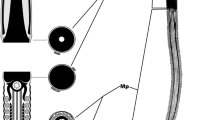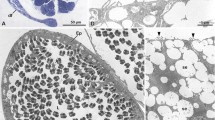Abstract
In Dolioletta gegenbauri and Doliolum nationalis, collected in 1987 in the bay of Villefranche-sur-mer (French Mediterranean Sea), spermiogenesis is essentially the same. Early spermatids have a round head, a flagellum arising from a single centriole with short microtubules at 45° to its base, several mitochondria, and an acrosome 50 nm thick and 250 nm long with its long axis parallel to the plasma membrane. The acrosomal contents are dense, with a central denser plate. The nuclear envelope next to the acrosome is thickened and concave. In elongating nuclei, strands of chromatin become oriented parallel to the length of the nucleus and then twist helically. Although the mitochondria surround the nucleus, they remain relatively short and do not fuse into a single mitochondrion as in sperm of other tunicates. In very late doliolid spermatids, the acrosome undergoes exocytosis, and exposes fibrous material that stays associated with the tip of the sperm; no acrosomal tubule forms. Exocytosis at this stage may be triggered by fixation. If so, exocytosis probably occurs naturally at some time before fusion of sperm and egg. Sperm have elongate heads (1 μm×10 μm), with the anterior two-thirds of the nucleus surrounded by mitochondria. Spermiogenesis in doliolids, compared to that in other tunicates, is most like that in solitary members of the class Ascidiacea, except that in the latter the sperm mitochondria fuse and the acrosome appears incapable of exocytosis. In contrast, previous work has shown that salps (class Thaliacea) and colonial didemnid ascidians have an acrosomeless sperm with a spiral mitochondrion, while the class Appendicularia has a sperm with a midpiece, a compact head and an acrosome capable of exocytosis and acrosomal tubule formation. By outgroup comparison with echinoderms and acraniates, appendicularian sperm are plesiomorphic within the Tunicata. Thus, gamete morphology indicates that (1) solitary ascidians and doliolids had a common ancestor, (2) the popular idea that doliolids gave rise to appendicularians is incorrect, and (3) the Thaliacea are polyphyletic, doliolids having arisen very early from the ascidian lineage and salps having arisen later.
Similar content being viewed by others
Literature cited
Balfour, F. M. (1885). A treatise on comparative embryology. 2nd ed. Vol. 2. MacMillan, London
Berrill, N. J. (1950). The Tunicata with an account of the British species. Ray Society, London
Berrill, N. J. (1955). The origin of the vertebrates. Oxford University Press, London
Bone, Q. (1963). The origin of the chordates. Zool. J. Linn. Soc. 44: 252–269
Braconnot, J. C. (1964). Sur le développement de la larve de Doliolum denticulatum Q et G. C. r. hebd. Séanc. Acad. Sci., Paris (Sér. D) 259: 4361–4383
Branconnot, J. C., Casanova, J. P. (1967). Sur le tunicier pélagique Doliolum nationalis Borgert 1893 en Méditerranée occidentale. Revue Trav. Inst. (scient. tech.) Pêch. marit. 31: 393–402
Braconnot, J. C. (1968). Sur le développement de la larve du tunicier pélagique doliolide: Doliolum (Dolioletta) gegenbauri Ulj. 1884. C. r. hebd. Séanc. Acad. Sci. Paris (Sér. D) 267: 629–630
Braconnot, J. C. (1977). Sur le cycle sexué chez le tunicier pélagique Doliolum nationalis Borg, 1893, avec la première description du stade oozoide. C. r. hebd. Séanc. Acad. Sci., Paris (Sér. D.) 284: 835–837
Braconnot, J. C., Katavic, I. (1979). L'existence du cycle sexué dans certaines populations du tunicier pélagique Doliolum nationalis en Méditerranée occidentale et en Adriatique. Rapp. P.-v. Réun. Commn int. Explor. scient. Mer. Medditerr. 25/26 (8): 163–165
Brien, P. (1948). Embranchement des tuniciers. Traité Zool. 11: 553–894
Brooks, W. K. (1893). The genus Salpa. Mem. biol. Lab. Johns Hopkins Univ. 2: 1–396, 57 plates
Burighel, P., Martinucci, G. B., Balia, G. (1982). The spermatozoa of the ascidians Botryllus schlosseri and Diplosoma listerianum (Urochordata). Caryologia 35: 127–128
Burighel, P., Martinucci, G. B., Magri, F. (1985). Unusual structures in the spermatozoa of the ascidians Lissoclinum perforatum and Diplosoma listerianum (Didemnidae). Cell Tissue Res. 241: 513–521
Cloney, R. A., Abbott, L. C. (1980). The spermatozoa of ascidians: acrosome and nuclear envelope. Cell Tissue Res. 206: 261–270
Cotelli, F., De Santis, R., Rosati, F., Monroy, A. (1980). Acrosome differentiation in the spermatogenesis of Ciona intestinalis. Dev. Growth Differentiation 22: 561–569
Deibel, D. R. (1980). Feeding, growth and swarm dynamics of neretic tunicates from the Georgia Bight. Ph. D. dissertation, University of Georgia
De Santis, R., Jamunno, G., Rosati, F. (1980). A study of the chorion and the follicle cells in relation to the sperm-egg interaction in the ascidian, Ciona intestinalis. Devl Biol. 74: 490–499
Dhandapani, P. (1975). Some observations on self-fertilization among Doliolida (pelagic Tunicata). Pubbl Staz. zool. Napoli 39 (Suppl.): 108–113
Fenaux, R. (1967). Les appendiculaires des mers d'Europe et du Bassin Méditerranéen. Faune Eur. Bassin méditerr. 2: 1–113
Flood, P. R., Afzelius, B. A. (1978). The spermatozoon of Oikopleura dioica Fol (Larvacea, Tunicata). Cell Tissue Res. 191: 27–37
Fol, H. (1872). Etudes sur les appendicularies du detroit de Messine. Mém. Soc. Phys. Hist. nat. Genève 21 (2): 1–55 11 plates
Franzén, Å. (1956). On spermiogenesis, morphology of the spermatozoon and biology of fertilization among invertebrates. Zool. Bidr. Upps. 31: 354–482
Franzén, Å. (1958). On sperm morphology and acrosome filament formation in some Annelida, Echiuroidea, and Tunicata. Zool. Bidr. Upps. 33: 1–28
Franzén, Å. (1976). The fine structure of spermatid differentiation in a tunicate Corella parallogramma (Müller). ZOON 4: 115–120
Franzén, Å. (1983). Urochordata. In: Adiyodi, K. G., Adiyodi, R. G. (eds.) Reproductive biology of invertebrates. Vol. 2. John Wiley & Sons, Chichester, p. 621–623
Fukumoto, M. (1981). The spermatozoa and spermiogenesis of Perophora formosana (Ascidia) with special reference to the striated apical structure and the filamentous structures in the mitochondrion. J. Ultrastruct. Res. 77: 37–53
Fukumoto, M. (1983). Fine structure and differentiation of the acrosome-like structure in the solitary ascidians, Pyura haustor and Styela plicata. Dev. Growth Differentiation 25: 503–515
Fukumoto, M. (1984a). Fertilization in ascidians: acrosome fragmentation in Ciona intestinalis spermatozoa. J. Ultrastruct. Res. 87: 252–262
Fukumoto, M. (1984b). The apical structure in Perophora annectens (Tunicate) spermatozoa: fine structure, differentiation and possible role in fertilization. J. Cell Sci. 66: 175–187
Fukumoto, M. (1985). Acrosome differentiation in Molgula manhattensis (Ascidiacea, Tunicata). J. Ultrastruct. Res. 92: 158–166
Fukumoto, M. (1986). The acrosome in ascidians. I. Pleurogona. Int. J. Invertebrate Reprod. Dev. (Amsterdam) 10: 335–346
Fukumoto, M. (1988). Fertilization in ascidians: apical processes and gamete fusion in Ciona intestinalis spermatozoa. J. Cell Sci. 89: 189–196
Garstang, W. (1928). The morphology of the Tunicata, and its bearing on the phylogeny of the Chordata. Q. Jl microsc. Sci. 72: 51–187
Gegenbaur, K. (1878). Grundriß der vergleichenden Anatomie. Wilhelm Engelmann, Leipzig
Georges, D. (1969). Spermatogenèse et spermiogenèse de Ciona intestinalis L. observées au microscope électronique. J. Microscopie 8: 391–400
Gould-Somero, M., Holland, L. Z. (1975). Oocyte differentiation in Urechis caupo (Echiura): a fine structural study. J. Morph. 147: 475–505
Grobben, D. (1882). Doliolum und sein Generationswechsel. Arb. Zool. Inst. Univ. Wien 4: 201–298
Heider, K., Tunicata (1900). In: Korscheldt, E., Heider, K. (eds.) Textbook of the embryology of invertebrates. Sonnenschein, London, p. 334–534 [Translated from German by M. Bernard and M. W. Woodward]
Herdman, W. (1888). Report on the Tunicata collected by HMS Challenger during the years 1873–1876. Rep. scient. Results Voyage HMS Challenger (s. Zool.) 27: 1–157
Holland, L. Z. (1988). Spermatogenesis in the salps Thalia democratica and Cyclosalpa affinis (Tunicata, Thaliacea): an electron microscopic study. J. Morph. 198: 189–204
Holland, L. Z., Gorsky, G., Fenaux, R. (1988). Fertilization in Oikopleura dioica (Tunicata: Appendicularia): acrosome reaction, cortical reaction and sperm-egg fusion. Zoomorphology 108 (4): in press
Honegger, T. G. (1986). Fertilization in ascidians: studies on the egg envelope, sperm and gamete interactions in Phallusia mammillata. Devl Biol. 118: 118–128
Huxley, T. H. (1851). Observations upon the anatomy and physiology of Salpa and Pyrosoma, together with remarks upon Doliolum and Appendicularia. Phil. Trans. R. Soc. 1851 (2): 457–605
Jefferies, R. P. S. (1987). The ancestry of the vertebrates. British Museum (Natural History), London
Julin, C. (1896). Recherches sur la blastogenèse chez Distaplia magnilarva et D. rosea. Compte-rendu des séances de troisième congrès internationale de zoologie, Leyde 16–21 septembre 1985. Leyde, E. J. Brill, p. 507–524
Julin, C. (1904a). Recherches sur la phylogenèse des tuniciers. Développement de l'appareil branchial. Z. wiss. Zool. 76: 544–611
Julin, C. (1904b). Recherches sur la phylogenèse des tuniciers. Archiascidia neapolitana nov. gen., nov. sp. Mitt. zool. Stn Neapel 16: 489–551
Lohmann, J. (1933). Erster Unterstamm der Chordata. Tunicata=Manteltiere. Allgemeine Einleitung in die Naturgeschichte der Tunicata. Handb. Zool. 5 (2): 3–14
Metcalf, M. M. (1918). The Salpidae: a taxonomic study. Bull. U.S. natn. Mus. 100 (2: 2): 1–193
Neumann, G. (1933) Zweite Klasse der Tunicata. Acopa=Caducichordata. Erste Unterklasse der Acopa Thaliaceae. Handb. Zool. 5 (2): 203–400
Pictet, C. (1891). Recherches sur la spermatogenèse chez quelques invertébrés de la Méditerranée. Mitt. zool. Stn Neapel 10: 75–152
Remane, A., Storch, B., Welsch, U. (1976). Systematische Zoologie, Stämme des Tierreichs. 1. ed. Fischer, Stuttgart
Retzius, G. (1904). Zur Kenntnis der Spermien der Evertebraten. I. Biol. Unters. (N.F.) 11: 1–32
Retzius, G. (1905). Zur Kenntnis der Spermien der Evertebraten. II. Biol. Unters. (N.F.) 12: 79–102
Rosati, F., De Santis, R. (1978). Studies on fertilization in the ascidians. I. Self-sterility and specific recognition between gametes of Ciona intestinalis. Expl Cell Res. 112: 111–119
Rosati, F., Pinto, M. R., Casazza, G. (1985). The acrosomal region of the spermatozoon of Ciona intestinalis: its relationship with the binding to the vitelline coat of the egg. Gamete Res. 11: 879–889
Schabtach, E., Ursprung, H. (1965). The fine structure of the sperm of a tunicate, Ascidia nigra. J. exp. Zool. 159: 357–366
Seeliger, O. (1893–1911). Tunicata: Mantelthiere. Bronn's Kl. Ordn. Tierreichs 3 (Suppl): 1–1773
Tuzet, O., Bogaraze, D., Lafargue, F. (1972). Recherches ultrastructurales sur la spermiogenèse de Diplosoma listerianum (Milne-Edwards, 1841) et Lissoclinum pseudoleptoclinum (Von Drasche, 1883) (Ascidies composées, Aplousobranches). Annls Sci. nat. (Zool.) (12e Sér.) 14: 177–190
Tuzet, O., Bogaraze, Lafargue, F. (1974). La spermatogenèse de Polysyncraton lacazei, 1872 et Trididemnum cereum Giard, 1872 (Ascidies composées, Aplousobranches). Bull. biol. Fr. Belg. 108: 151–167
Tuzet, O., Harant, H. (1930). Sur la spermatogenèse d'une ascidie: Styela partita Stimpson. C. r. Séanc. Soc. Biol. 105: 299–301
Uljanin, B. (1884). Die Arten der Gattung Doliolum im Golfe von Neapel und den angrenzenden Meeresabschnitten. Fauna Flora Golfo Neapel 10: 1–140
Van Name, W. G. (1921). Budding in compound ascidians and other invertebrates, and its bearing on the question of the early ancestry of the vertebrates. Bull. Am. Mus. nat. Hist. 44: 275–282
Villa, L. (1981). An electron microscope study of spermiogenesis and spermatozoa of Molgula impura and Styela plicata (Ascidiacea, Tunicata). Acta Embryol. Morph. exp. (N.S.) 2: 69–85
Villa, L., Tripepi, S. (1983). An electron microscope study of spermatogenesis and spermatozoa of Ascidia malaca, Ascidiella aspersa and Phallusia mammillata (Ascidiacea, Tunicata). Acta Embryol. Morph. exp. (N.S.) 4: 157–168
Willey, A. (1894). Amphioxus and the ancestry of the vertebrates. MacMillan, New York & London
Wirth, U. (1984). Die Struktur der metazoen Spermien und ihre Bedeutung für die Phylogenetik. Verh. naturw. Ver. Hamb. 27: 295–362
Woollacott, R. M. (1977). Spermatozoa of Ciona intestinalis and analysis of ascidian fertilization. J. Morph. 152: 77–88
Young, J. Z. (1981). Life of the vertebrates. 3rd ed. Clarendon Press, Oxford, New York
Author information
Authors and Affiliations
Additional information
Communicated by P. C. Schroeder, Pullman
Rights and permissions
About this article
Cite this article
Holland, L.Z. Fine structure of spermatids and sperm of Dolioletta gegenbauri and Doliolum nationalis (Tunicata: Thaliacea): implications for tunicate phylogeny. Mar. Biol. 101, 83–95 (1989). https://doi.org/10.1007/BF00393481
Accepted:
Issue Date:
DOI: https://doi.org/10.1007/BF00393481




